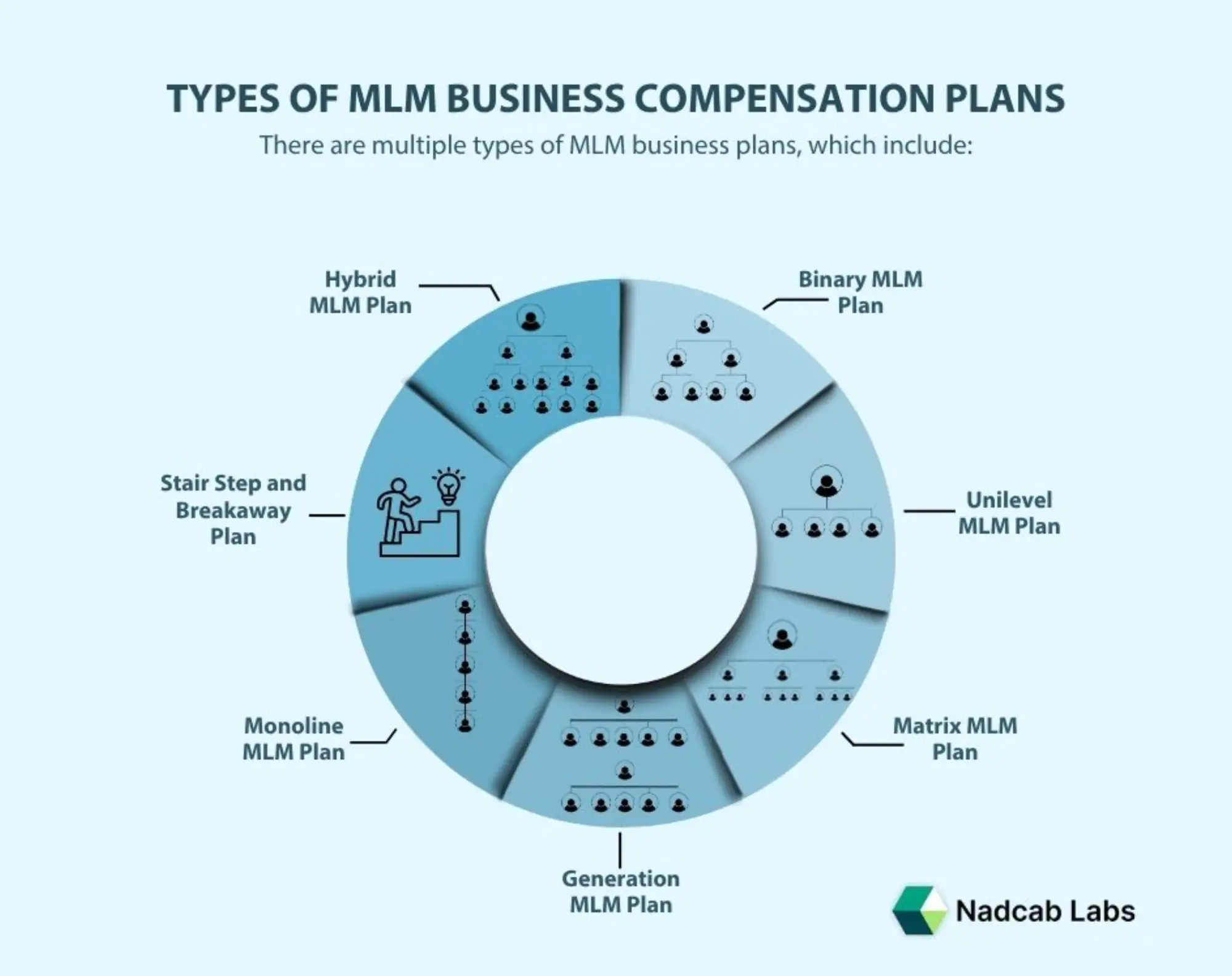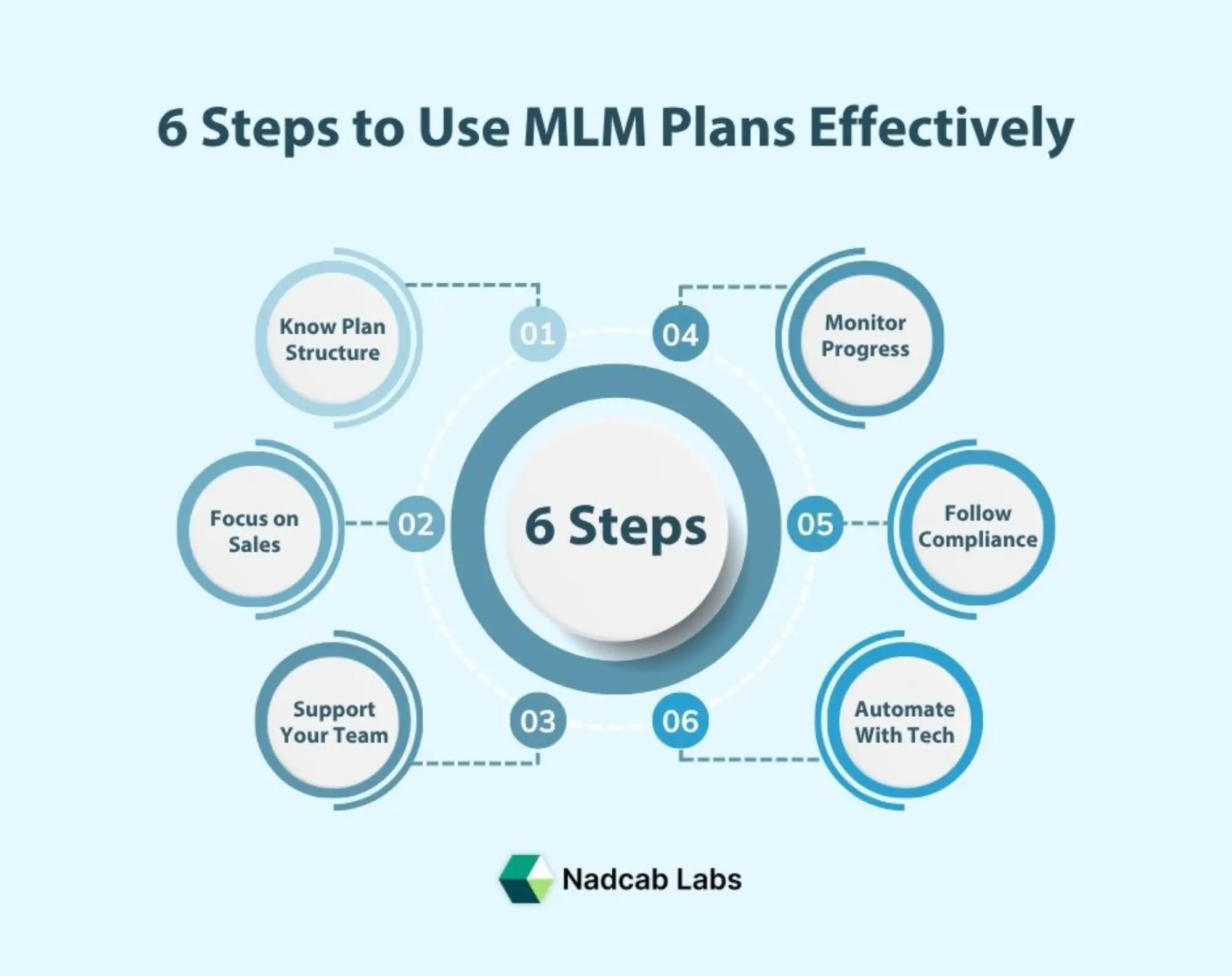Have you ever wondered how people earn income through network marketing or direct selling? The secret behind it lies in something called an MLM Plan.
An MLM (Multi-Level Marketing) Plan is the backbone of any network marketing business. It defines how distributors earn money not only from their personal sales but also from the sales made by the people they bring into the network. In simple terms, it is the system that keeps the entire network running smoothly by tracking commissions, bonuses, and team performance.
Just like a business blueprint guides a company’s growth, an MLM plan decides how earnings are shared across multiple levels of distributors. Every successful network marketing company, from wellness brands to digital service providers, depends on a well-structured MLM plan to manage rewards, motivate members, and ensure long-term growth.
According to the World Federation of Direct Selling Associations (WFDSA), the global direct selling industry generated $167.7 billion in retail sales in 2023, with over 102 million independent distributors participating in network-based businesses worldwide. This shows that MLM plans are not just theories but practical systems that drive one of the world’s largest people-powered industries.
In this blog, we will break down what an MLM plan really means, the major types of MLM plans, and how they work in real business models so you can understand which one suits your goals best.
What is an MLM Business Plan?
An MLM business, or multi-level marketing business, is a sales model where participants earn money in two ways: by selling products directly to customers and by earning commissions from the sales made by team members they recruit. Each recruited member forms a “downline,” which is a group of distributors under a participant, creating a structured hierarchy that allows participants to earn from both their own sales and the sales of their downline.
To manage this hierarchy, different types of MLM business plans are used. An MLM business plan is the core system that defines how a network marketing company operates, distributes commissions, and grows its distributor network.
To understand it better, you should first know the MLM meaning, which refers to Multi Level Marketing and focuses on earning through product sales and team growth. It outlines the complete earning structure, showing how distributors make money from both direct sales and the teams they build. In simpler terms, it acts as a roadmap that connects people, products, and profits in a transparent way. Without a proper MLM plan, a network marketing company cannot manage payouts or ensure long term growth.
Read Also: What Is MLM, How It Works, and How to Earn Through It?
A well-designed MLM business plan helps:
- Motivate distributors to grow their teams and sales.
- Maintain fair commission distribution across multiple levels.
- Build a sustainable structure that supports business expansion.
- Ensure compliance with regional direct selling laws and regulations.
Different companies choose different types of MLM plans based on their product type, target audience, and reward strategy. Let’s explore the most popular types of MLM business plans used around the world.
Types of MLM Business Plans
In a network marketing business, every company follows a specific MLM plan that defines how income is earned and how the team grows. These structures are often called MLM compensation plans, as they determine how commissions, bonuses, and rewards are shared among distributors. Understanding these plans helps you choose the right model for your business goals.
Below are the most common and popular types of MLM plans used worldwide:
- Binary MLM Plan
- Unilevel MLM Plan
- Matrix MLM Plan
- Generation MLM Plan
- Stair Step & Breakaway Plan
- Monoline MLM Plan
- Hybrid MLM Plan
- Investment / ROI Based MLM Plan
- Custom MLM Plans for Cryptocurrency
Let’s explore each type of multi-level marketing business plan to understand what it is and how it is used.

Binary MLM Plan
A Binary MLM Plan is one of the simplest and most widely used models in network marketing. In this plan, each distributor adds two people under them who form the left and right leg of their team. The income is calculated when both legs have balanced sales, which is known as pairing income.
This plan is very common in wellness, beauty, and product-based industries because it promotes teamwork and steady growth. It is ideal for beginners who want a simple structure and easy management. The MLM compensation plan in this model rewards members based on how well they balance both sides of their team, which leads to stable earnings over time.
Unilevel MLM Plan
The Unilevel MLM Plan allows a distributor to recruit as many members as they want in their first level. Everyone who joins under them forms a wide and strong base. The next members added by those recruits form the second level, and the process continues downward.
This plan is popular in industries like education, digital marketing, and e-commerce where wider personal recruitment brings more sales. It is easy to understand and gives full control to distributors on how large they want their network to be. The Unilevel MLM compensation plan is known for rewarding direct effort and helping distributors build broad and active teams.
Matrix MLM Plan
A Matrix MLM Plan works in a fixed structure like three by five or five by seven. This means every distributor can add a limited number of members on their first level and earn commissions for a limited number of levels deep. Once a level is full, the next new member is placed under someone else in the team automatically.
This plan is most common in software, service, and product distribution industries where companies want controlled and organized growth. It encourages teamwork because every new recruit helps the entire structure to grow. The Matrix plan is perfect for companies that want balanced progress for all members and clear earning potential within their MLM compensation structure.
Generation MLM Plan
A Generation MLM Plan is designed to reward leadership and consistent performance. In this plan, the network is divided into groups known as generations. Each generation is built based on rank and sales achievement. Distributors earn from their own sales as well as from the performance of their generations.
This plan is most often used by large and product-focused companies, especially in health, cosmetics, and personal care sectors. It supports long-term business stability because it rewards people who help others succeed. Generation plans create a sense of teamwork, loyalty, and leadership within the network.
Monoline MLM Plan
The Monoline MLM plan, also known as the Linear MLM plan, is one of the simplest MLM compensation structures. In this system, every new member joins under a single line, one after another, forming a straight chain of distributors. This means there is only one downline for everyone in the network, and all participants earn commissions based on their position in this single line.
This plan is popular among companies that want to promote teamwork and equal growth opportunities. Since every new member supports the entire chain, it motivates everyone to contribute actively to sales and recruitment. The Monoline plan is often used in digital product-based MLM companies and blockchain-based projects because it offers simple management and transparent earning distribution.
In simple terms, a Monoline MLM plan is easy to understand, easy to manage, and perfect for companies that want a balanced and community-driven growth structure within their MLM compensation model.
Stair Step and Breakaway Plan
A Stair Step Plan allows distributors to climb higher ranks based on their sales volume and team growth. Each step gives them more bonuses, higher commissions, and recognition. Once a distributor reaches a certain level, they move to the Breakaway stage where they start earning independently while still being a part of the main network.
This plan is widely used by traditional direct selling companies like cosmetic and wellness brands that focus on large sales networks. It helps individuals grow from being new sellers to successful leaders. The Stair Step and Breakaway MLM compensation plan motivates people to improve their performance and mentor their teams to achieve collective success.
Hybrid MLM Plan
A Hybrid MLM Plan combines the best features of different MLM models such as Binary, Matrix, and Unilevel. This approach gives flexibility and balance to both the company and distributors. It helps companies customize their reward structure based on the type of products and business goals they have.
This plan is popular among global brands and tech-driven companies that want to attract both new and experienced distributors. Hybrid plans offer quick payouts, strong retention, and sustainable growth. It is ideal for modern businesses that want to stay competitive with innovative MLM compensation systems that blend multiple plan types into one seamless model.
Investment or ROI Based MLM Plan
An Investment MLM Plan, also called an ROI Based Plan, allows members to invest a specific amount of money and earn regular returns based on the company’s business activities. These returns can be daily, weekly, or monthly depending on the system.
This model is often seen in real estate, finance, and digital asset industries where profits are shared from verified revenue sources. While this plan can offer attractive returns, it must always follow legal rules and stay transparent to avoid being mistaken for a money circulation scheme. A trusted and registered platform is essential for safety and credibility.
Custom MLM Plans for Cryptocurrency Projects
Custom MLM Plans for cryptocurrency projects are built using blockchain technology. These plans run through smart contracts that automatically handle commissions, team tracking, and transaction records. Everything is managed digitally with full transparency.
This model is growing rapidly in blockchain and digital finance industries where companies want to offer real-time crypto rewards. It supports multiple plan types such as Binary, Matrix, or Hybrid structures and provides instant and accurate payouts through blockchain networks like Ethereum, Tron, or Binance Smart Chain.
Crypto-based MLM compensation plans are shaping the future of network marketing by combining automation, security, and global accessibility in one system.
How to Use MLM Plans Effectively?
Selecting an MLM plan is only the first step. To achieve long-term success, it’s important to know how to use these plans effectively. Whether you’re building your own MLM company or joining one as a distributor, a clear strategy helps you grow faster and maintain a stable income. Let’s explore how to make the most out of your MLM compensation plan in simple and practical ways.

1. Understand the Plan Structure Clearly
Before starting, study the complete plan and understand how commissions, bonuses, and rewards are distributed. Know how many levels are included, what the qualification rules are, and what kind of sales volume you need to earn income. Having full knowledge of the plan keeps you away from confusion and helps you plan your goals properly.
2. Focus on Product Sales, Not Just Recruitment
The true success of network marketing depends on genuine product sales, not only on adding new members. Always choose products that have real market demand and good quality. When your customers are satisfied, your business naturally grows. This approach also ensures that your MLM activity stays compliant with direct selling guidelines in most countries.
3. Build and Train a Strong Team
Your team is the foundation of your MLM business. Share your knowledge with your downline and help them understand how the plan works. Organize small training sessions, webinars, or product demonstrations to build trust and motivation. A well-trained team helps create a smooth and sustainable income flow within the MLM structure.
4. Track Performance Regularly
Successful distributors constantly track their team’s performance and sales activities. Use reports, dashboards, or software tools to monitor progress. This helps you identify which areas are performing well and where improvement is needed. Consistent tracking supports better decision-making and avoids unnecessary losses.
5. Stay Transparent and Follow Compliance Rules
Transparency is the key to long-term success in MLM. Make sure that all your promotional messages and income claims are truthful and based on real data. Follow your region’s direct selling and consumer protection regulations strictly. A transparent system builds trust and strengthens your network.
6. Use Technology and Automation
Modern MLM businesses are moving toward automation through MLM software and blockchain-based smart contracts. These tools manage commissions, transactions, and team reports automatically, saving time and reducing errors. Automation not only makes your MLM compensation system more reliable but also creates a sense of fairness and efficiency across your network.
When you apply these principles consistently, your MLM business becomes more professional, transparent, and growth-oriented. Every successful network marketer focuses on building relationships, providing value, and using the plan intelligently rather than chasing short-term results.
Common Mistakes to Avoid in MLM Compensation Plans
Even the best MLM compensation plans can fail if not used correctly. Many beginners repeat the same errors that slow down their growth and affect their team performance. Here are some of the most common mistakes to avoid if you want long-term success in network marketing:
- Ignoring product quality: Always promote genuine and useful products instead of focusing only on recruitment.
- Not understanding the plan structure: Study the complete plan, including levels, commissions, and rewards before joining.
- Making false income claims: Avoid overpromising quick wealth; focus on real sales and honest growth.
- Weak team communication: Stay connected with your team through meetings, training, and regular support.
- Skipping technology: Use reliable MLM software or automation tools to manage payouts and track team performance.
- Not following legal rules: Every country has its own guidelines for MLM and direct selling; staying compliant keeps your business safe and trusted.
Build Your Crypto MLM Platform with Nadcab
Transform your business with secure, scalable, and customizable crypto MLM software.
The Evolution of Blockchain in MLM: Trends Shaping 2025-26
As network marketing moves further into the digital age, blockchain technology is becoming a powerful tool for bringing transparency, trust, and automation to MLM systems. What started as a simple technology for recording cryptocurrency transactions has now developed into a strong network of smart contracts that help manage payments, secure data, and remove the need for middlemen. This change is solving many old problems in MLM, such as payment delays, errors in commission tracking, and lack of trust.
In 2025, the use of blockchain in MLM is growing faster than ever. According to a report by Grand View Research, the global blockchain market is expected to grow at a rate of around 90.1% per year from 2025 to 2030 1 ,as more industries look for transparent and decentralized systems. Through multiple sources, such as the Meltwater report, it is observed that the world of cryptocurrency is expanding rapidly, with around 9.9% of the global population, nearly 559 million people, using crypto. India leads in global adoption with over 100 million crypto users, followed by strong growth across South Asia.2 3 4
The MLM software market is following the same direction. The global market for MLM software was valued at 1.5 billion dollars in 2024 and is expected to reach 3.7 billion dollars by 2032.5 Many of these new MLM platforms are using blockchain features like smart contracts, especially on popular networks such as Ethereum and Tron..
Several important trends are shaping this transformation:
- Automation through smart contracts is making commission payments faster and more accurate. Once the conditions are met, the system automatically sends payouts without human involvement.
- Digital rewards and crypto earnings are becoming common, as MLM companies use tokens, stablecoins, and even NFTs to reward their members.
- Global participation and compliance are improving because blockchain makes it easy for anyone in any country to join while keeping all records secure and verifiable.
- Cost efficiency and scalability are increasing as blockchain reduces the need for manual work and middle layers, helping MLM businesses grow faster at a lower cost.
These trends are not only changing the structure of MLM plans but also building stronger trust between companies and their distributors. Many industries, from wellness and education to fintech, are now using blockchain-powered MLM systems to manage operations more efficiently and fairly.
How Blockchain Based Crypto MLM Software is Empowering the Industry
Blockchain technology is changing how MLM businesses operate by bringing automation, transparency, and trust into every process. Through the use of blockchain-based MLM software, companies can now manage their networks more efficiently, automate payments, and ensure complete accuracy in commission distribution.
Support for every MLM plan
Modern crypto MLM software supports all major plan types such as Binary, Matrix, Hybrid, and Unilevel. Each plan can be customized through smart contract MLM systems that automatically calculate earnings and distribute rewards without manual effort.
Tools that support business growth
These platforms include essential tools like integrated crypto wallets, NFT-based reward programs, and real-time performance analytics. With multi-language dashboards and mobile-friendly interfaces, MLM businesses can easily expand their networks across global markets.
Strong security and compliance
Blockchain’s encrypted structure helps protect sensitive user data and ensures all transactions are verifiable. Automated reporting also supports compliance with international direct selling and digital asset regulations, creating a secure and transparent ecosystem for all participants.
Proven industry results
Many MLM companies adopting blockchain-based solutions have reported faster member onboarding, higher payout accuracy, and better trust among distributors. The growing number of crypto users worldwide shows how digital rewards and decentralized systems are shaping the future of network marketing.
By adopting smart contract-based MLM software, businesses are moving toward a more efficient, secure, and globally connected future. The integration of blockchain into MLM systems marks a major step forward in building transparency and reliability across the industry.
Final Thoughts
In network marketing, the right MLM plan is the key to long-term success. From traditional Binary models to modern blockchain-based systems, the goal is to choose a structure that builds trust, supports transparency, and helps you grow globally.
With blockchain emerging as one of the fastest-growing technologies worldwide, now is the perfect time to upgrade your MLM business. Whether you are starting a new venture or expanding an existing network, using blockchain will help you create a more reliable and profitable system.
Frequently Asked Question - MLM Business
The best MLM system depends on your business goals and team size. For beginners, Unilevel and Binary plans are the most popular because they are easy to manage and understand. Businesses looking for long-term scalability often choose Matrix or Hybrid MLM systems, which balance growth and rewards. Today, many companies use smart contract-based MLM software for automation and transparency through blockchain technology.
Network marketing follows a step-by-step approach that helps build a strong and sustainable business:
- Choose the right MLM company that offers genuine products and a fair plan.
- Understand the compensation plan to know how earnings are calculated.
- Create a clear business strategy for recruitment and sales.
- Use digital tools like MLM software to track performance and payouts.
- Build and train your team to increase sales and engagement.
- Maintain customer relationships for repeat purchases.
- Stay compliant with direct selling laws and ethical practices.
MLM compensation plans, also known as MLM business plans, define how members earn money in a network marketing business. They outline commissions, bonuses, and rewards for sales and team building, ensuring fair and transparent income distribution across the network. While the terms are often used interchangeably, the compensation plan specifically focuses on payment structure, whereas the business plan covers the overall strategy and operations.
The four basics of network marketing are product, people, plan, and promotion. A strong product ensures customers trust and value what they buy. Building and nurturing relationships with people, including customers and distributors, drives growth and retention.
Multi-Level Marketing (MLM) is a business model where individuals earn money by selling products and recruiting others to join the network. Each person earns commissions not only from their direct sales but also from the sales made by their team.
Yes, MLM (Multi-Level Marketing) is legal in many countries when it operates under government-approved rules and regulations. Legitimate MLM companies focus on selling real products or services rather than promoting money-circulation or pyramid schemes, which are illegal in most regions.
It is important to understand MLM legality globally because regulations vary from country to country. Knowing these legal frameworks helps individuals identify genuine business opportunities, stay compliant, and avoid fraudulent schemes.
Reviewed By

Aman Vaths
Founder of Nadcab Labs
Aman Vaths is the Founder & CTO of Nadcab Labs, a global digital engineering company delivering enterprise-grade solutions across AI, Web3, Blockchain, Big Data, Cloud, Cybersecurity, and Modern Application Development. With deep technical leadership and product innovation experience, Aman has positioned Nadcab Labs as one of the most advanced engineering companies driving the next era of intelligent, secure, and scalable software systems. Under his leadership, Nadcab Labs has built 2,000+ global projects across sectors including fintech, banking, healthcare, real estate, logistics, gaming, manufacturing, and next-generation DePIN networks. Aman’s strength lies in architecting high-performance systems, end-to-end platform engineering, and designing enterprise solutions that operate at global scale.






